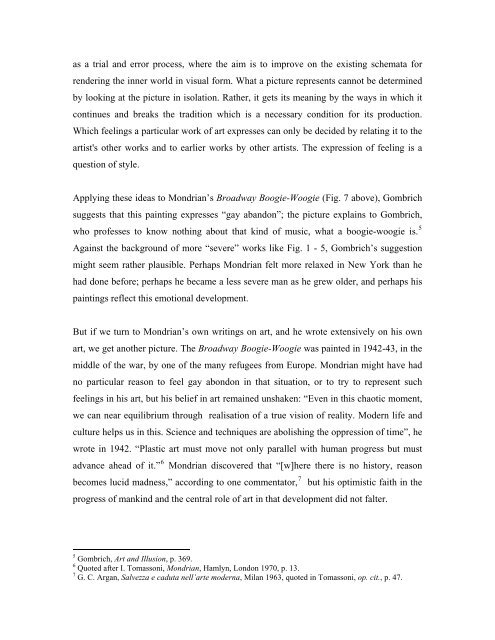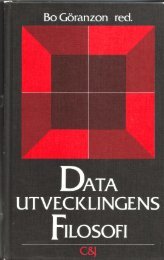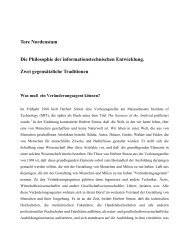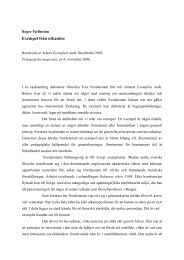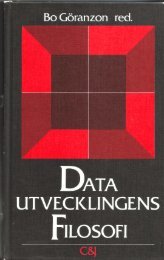tore nordenstam explanation and understanding in the history of art
tore nordenstam explanation and understanding in the history of art
tore nordenstam explanation and understanding in the history of art
You also want an ePaper? Increase the reach of your titles
YUMPU automatically turns print PDFs into web optimized ePapers that Google loves.
as a trial <strong>and</strong> error process, where <strong>the</strong> aim is to improve on <strong>the</strong> exist<strong>in</strong>g schemata for<br />
render<strong>in</strong>g <strong>the</strong> <strong>in</strong>ner world <strong>in</strong> visual form. What a picture represents cannot be determ<strong>in</strong>ed<br />
by look<strong>in</strong>g at <strong>the</strong> picture <strong>in</strong> isolation. Ra<strong>the</strong>r, it gets its mean<strong>in</strong>g by <strong>the</strong> ways <strong>in</strong> which it<br />
cont<strong>in</strong>ues <strong>and</strong> breaks <strong>the</strong> tradition which is a necessary condition for its production.<br />
Which feel<strong>in</strong>gs a p<strong>art</strong>icular work <strong>of</strong> <strong>art</strong> expresses can only be decided by relat<strong>in</strong>g it to <strong>the</strong><br />
<strong>art</strong>ist's o<strong>the</strong>r works <strong>and</strong> to earlier works by o<strong>the</strong>r <strong>art</strong>ists. The expression <strong>of</strong> feel<strong>in</strong>g is a<br />
question <strong>of</strong> style.<br />
Apply<strong>in</strong>g <strong>the</strong>se ideas to Mondrian’s Broadway Boogie-Woogie (Fig. 7 above), Gombrich<br />
suggests that this pa<strong>in</strong>t<strong>in</strong>g expresses “gay ab<strong>and</strong>on”; <strong>the</strong> picture expla<strong>in</strong>s to Gombrich,<br />
who pr<strong>of</strong>esses to know noth<strong>in</strong>g about that k<strong>in</strong>d <strong>of</strong> music, what a boogie-woogie is. 5<br />
Aga<strong>in</strong>st <strong>the</strong> background <strong>of</strong> more “severe” works like Fig. 1 - 5, Gombrich’s suggestion<br />
might seem ra<strong>the</strong>r plausible. Perhaps Mondrian felt more relaxed <strong>in</strong> New York than he<br />
had done before; perhaps he became a less severe man as he grew older, <strong>and</strong> perhaps his<br />
pa<strong>in</strong>t<strong>in</strong>gs reflect this emotional development.<br />
But if we turn to Mondrian’s own writ<strong>in</strong>gs on <strong>art</strong>, <strong>and</strong> he wrote extensively on his own<br />
<strong>art</strong>, we get ano<strong>the</strong>r picture. The Broadway Boogie-Woogie was pa<strong>in</strong>ted <strong>in</strong> 1942-43, <strong>in</strong> <strong>the</strong><br />
middle <strong>of</strong> <strong>the</strong> war, by one <strong>of</strong> <strong>the</strong> many refugees from Europe. Mondrian might have had<br />
no p<strong>art</strong>icular reason to feel gay abondon <strong>in</strong> that situation, or to try to represent such<br />
feel<strong>in</strong>gs <strong>in</strong> his <strong>art</strong>, but his belief <strong>in</strong> <strong>art</strong> rema<strong>in</strong>ed unshaken: “Even <strong>in</strong> this chaotic moment,<br />
we can near equilibrium through realisation <strong>of</strong> a true vision <strong>of</strong> reality. Modern life <strong>and</strong><br />
culture helps us <strong>in</strong> this. Science <strong>and</strong> techniques are abolish<strong>in</strong>g <strong>the</strong> oppression <strong>of</strong> time”, he<br />
wrote <strong>in</strong> 1942. “Plastic <strong>art</strong> must move not only parallel with human progress but must<br />
advance ahead <strong>of</strong> it.” 6 Mondrian discovered that “[w]here <strong>the</strong>re is no <strong>history</strong>, reason<br />
becomes lucid madness,” accord<strong>in</strong>g to one commentator, 7 but his optimistic faith <strong>in</strong> <strong>the</strong><br />
progress <strong>of</strong> mank<strong>in</strong>d <strong>and</strong> <strong>the</strong> central role <strong>of</strong> <strong>art</strong> <strong>in</strong> that development did not falter.<br />
5 Gombrich, Art <strong>and</strong> Illusion, p. 369.<br />
6 Quoted after I. Tomassoni, Mondrian, Hamlyn, London 1970, p. 13.<br />
7 G. C. Argan, Salvezza e caduta nell’<strong>art</strong>e moderna, Milan 1963, quoted <strong>in</strong> Tomassoni, op. cit., p. 47.


